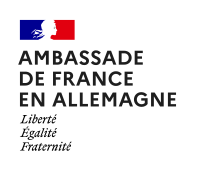
Egon Eiermann was one of Germany's most prominent architects in the second half of the 20th century. He was also a furniture designer. From 1947, he was Professor for architecture at Technische Hochschule Karlsruhe.
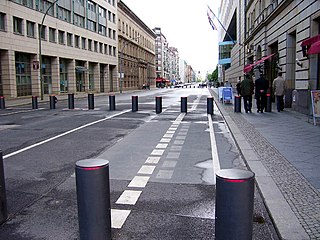
Wilhelmstrasse is a major thoroughfare in the central Mitte and Kreuzberg districts of Berlin, Germany. Until 1945, it was recognised as the centre of the government, first of the Kingdom of Prussia, later of the unified German Reich, housing in particular the Reich Chancellery and the Foreign Office. The street's name was thus also frequently used as a metonym for overall German governmental administration: much as the term "Whitehall" is often used to signify the British governmental administration as a whole. In English, "the Wilhelmstrasse" usually referred to the German Foreign Office.

Mohrenstraße is a Berlin U-Bahn station on line U2, located in the district of Mitte.

The Hotel Adlon Kempinski Berlin is a luxury hotel in Berlin, Germany. It is on Unter den Linden, the main boulevard in the central Mitte district, at the corner with Pariser Platz, directly opposite the Brandenburg Gate.

Bernhard Hans Henry Scharoun was a German architect best known for designing the Berliner Philharmonie and the Schminke House in Löbau, Saxony. He was an important exponent of organic and expressionist architecture.
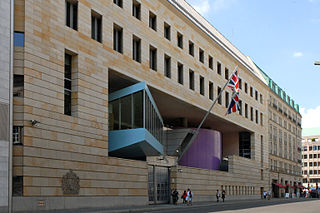
The British Embassy in Berlin is the United Kingdom's diplomatic mission to Germany. It is located on 70-71 Wilhelmstraße, near the Hotel Adlon, in Berlin. The current ambassador is Andrew Jonathan Mitchell CMG.
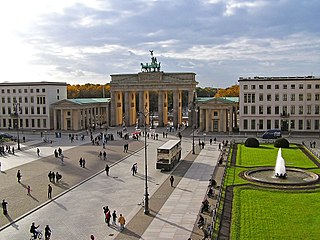
Pariser Platz is a square in the historic center of Berlin, Germany, situated by the Brandenburg Gate at the end of the Unter den Linden. The square is named after the French capital of Paris to commemorate the victory of the Sixth Coalition over the French Empire at the Battle of Paris (1814), and is one of the main focal points of the city.

The Palais Strousberg was a large city mansion built in Berlin, Germany for the railway magnate Bethel Henry Strousberg. It was designed by the architect August Orth and built between 1867–68 at No.70 Wilhelmstraße. The grandiose splendour of its accommodation and novel integration of the latest building technologies into the fabric of the building, ensured that Berliners would still find the Palais impressive decades after its construction, becoming the model of refined luxury in Berlin architecture.

The Embassy of the United States of America in Berlin is the diplomatic mission of the United States of America in the Federal Republic of Germany. It started in 1797, with the appointment of John Quincy Adams to Berlin, the capital of Prussia. There was no permanent building for the embassy until 1930, with the purchase of the Blücher Palace. During the United States involvement in World War II, the embassy ceased operations.
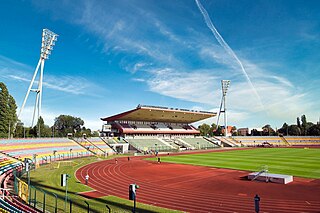
The Friedrich-Ludwig-Jahn-Sportpark is a multi-purpose sports complex located in the western part of the locality of Prenzlauer Berg in the borough of Pankow in Berlin. The sports complex covers an area of approximately 22 hectares and comprises several facilities. The main building is the Friedrich-Ludwig-Jahn-Stadion. The stadium is the third-largest stadium in Berlin, after the Olympiastadion and the Stadion An der Alten Försterei, with a capacity of approximately 20,000 seats, of which 15,000 are covered. The most recent main tenants of the stadium have been VSG Altglienicke and Berlin Thunder. Friedrich-Ludwig-Jahn-Sportpark was the venue for the 2018 World Para Athletics European Championships. The large stadium is planned for a complete redevelopment. Demolition of the stadium began on 8 October 2024.

Sasha Alexandra Waltz is a German choreographer, dancer and leader of the dance company Sasha Waltz and Guests.
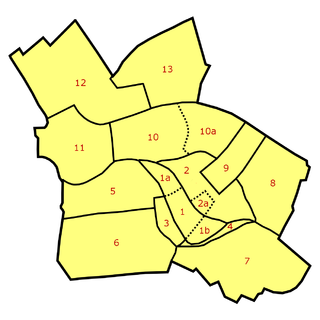
is a historic zone or neighbourhood (Stadtviertel) of central Berlin, Germany, which forms part of the locality (Ortsteil) of Mitte within the borough (Bezirk) also called Mitte. It contains several famous Berlin landmarks: the Brandenburg Gate, the Pariser Platz, and Unter den Linden.

The Hotel Adlon Kempinski Berlin is a luxury hotel in Berlin, Germany. It is on Unter den Linden, the main boulevard in the central Mitte district, at the corner with Pariser Platz, directly opposite the Brandenburg Gate.

Schwabenhass is a neologism referring to the aversion to the approximately 300,000-strong Swabian diaspora in Berlin and elsewhere in Germany outside of Swabia. In 2013, the so-called Spätzle-streit gained nationwide attention.
Kuehn Malvezzi is an architectural practice in Berlin founded by Johannes Kuehn, Wilfried Kuehn and Simona Malvezzi in 2001. They work as exhibition designers, architects and curators, with a focus on museums and public spaces.

Christoph Sattler is a prolific German architect who has been professionally active since the early 1970s. Most of his more prominent buildings are in southern Germany or Berlin. Although he is known for a number of large high-profile residential developments, he has also attracted widespread critical and public attention with public buildings and structures such as the Seeparkturm in Freiburg, the Kupferstichkabinett in Berlin, various underground stations such as those of Am Hart (Munich) and Mendelssohn-Bartholdy-Park (Berlin) and several art galleries including the controversial Gemäldegalerie in Berlin. He studied for several years during the 1960s in North America as a post-graduate student. During that period he was employed with the firm of Ludwig Mies van der Rohe.
Robert Suckale was a German art historian, medievalist and professor at Technische Universität Berlin.
Bruno Flierl was a German architect, architecture critic, and writer. His work focused on architecture, urban development, and city planning of East Germany. He assisted in the design of the Pariser Platz and argued for the preservation of the Palace of the Republic in the debate over the restoration of the Berlin Palace.

The Embassy of India, Berlin is the diplomatic representation of the Republic of India in the Federal Republic of Germany. The embassy building has been located in Tiergartenstraße in Berlin's embassy district since 2001. The first exchange of ambassadors between West Germany and India took place in 1952, after India was one of the first countries to recognize the then new Federal Republic of Germany in 1949. On March 7, 1951, both countries concluded a treaty to exchange ambassadors. Between 1972 and 1990 there was also an Indian embassy in the GDR.
Tanz im August is an annual festival for contemporary dance in Berlin. It was founded by Nele Hertling in West Berlin in 1988, and is now presented by the Hebbel am Ufer (HAU) theatre company on various stages in Berlin. It presents companies from all over the world with their new choreography, aesthetics and formats, new projects by Berlin artists, collaboration with international guests, and co-production for world premieres and German premieres. Virve Sutinen has been artistic director from 2014.


